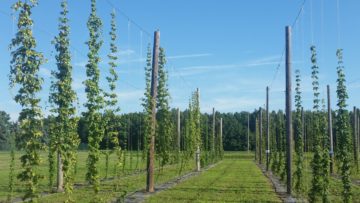By JAN LARSON McLAUGHLIN
BG Independent News
It took intense “hops sensory observations” – otherwise known as sitting around drinking beer – for some Ohio agriculture experts to raise a question.
Why aren’t Ohio farmers raising hops to supply all the craft beer makers popping up around the state?
“We got to thinking, can this be done in Ohio?” said Brad Bergefurd, a horticulture specialist with OSU Extension in Piketon. The answer is, yes, he told a crowded room at the Northwest Ohio Ag-Business Breakfast north of Bowling Green on Thursday.
Truth is, hops used to be grown in Ohio a century ago. But three factors shut down the beer-making crop – prohibition, downy mildew and pesky aphids.
The hops market in Washington and Oregon survived since those harvests were shipped overseas where alcohol was not banned. Those two states continue to grow the vast majority of hops used to make beer in the U.S.

Brad Bergefurd talks about growing hops in Ohio.
Bergefurd suggested that now may be the time for Ohio farmers to consider getting back in the hops business.
“One-hundred years ago we grew it,” he said. “We can do it.”
In fact, right on the ground of the agricultural incubator on Ohio 582, is a small quarter-acre hops yard. It is one of three scientific hops yards in Ohio, studying if farmers in this state could find a place in the beer trade.
The U.S. brews more than 5 billion gallons of beer a year. Small craft breweries are a growing trend, with the Ohio Department of Commerce reporting more than 186 in this state alone. Those breweries produce more than a million barrels of craft beer annually.
“There is quite a demand,” Bergefurd said. “Hops is what makes the beer.”
The other trend of using locally grown items, and publicizing those to customers, means Ohio brewers are looking for hops grown and raised in this region.
“The brewers would like to have more of a local product,” Bergefurd said.
“These guys and girls are investing millions in these breweries. They aren’t going away,” he said.
While Ohio farmers have picked up the pace, they have some distance to go if they want to supply local breweries. In 2012, there were just three hops farmers in the state, Bergefurd said. That number has grown to more than 60 members in a guild, with just over 200 acres planted in hops.
But in order to supply the state’s 186 craft beer makers, at least 6,000 acres of hops are needed, he said.
There are some challenges to growing hops – but it is definitely doable.

Hops growing at Ag Incubator Foundation.
Hops growing in a “yard,” as Bergefurd calls it, look different than most crops. Telephone poles are planted at the end of each row, with a wire strung between them. Then the hops bines (which they are called rather than vines) are twisted around twine that is connected to the high wires.
Bergefurd hopes to experiment soon with using galvanized trellises, rather than telephone poles.
The hops can grow 20-feet high, very quickly, up to one foot a day. They need “fed fast,” with nitrogen early in the season, then cut off after the summer solstice.
The roots can grow 15 to 20 feet deep, in any soil type. A plant can live 20 to 30 years, if farmers “keep it happy,” Bergefurd explained.
The young shoots from the hops can also be sold as delicacies to “white tablecloth restaurants,” he said.
Harvesting the hops is very labor intensive and time sensitive. The harvest window is very small – with the hops reaching readiness one day and 48 hours later being too far gone.
Few farmers have hops harvesting machines, so most of the work is done by hand. Bergefurd has helped in hops harvests, and said the “newness wears off” quickly and paying the hired help with the final product can get expensive. “The beer bill will kill you,” he said, smiling.
Bergefurd suggested that farmers find a market for their harvest before going into the hops business. Find out what kind of hops the craft beer makers want, since the different varieties create different beers.
“Brewers won’t tell you their secrets, their recipes,” but they will share what type of hops they want.
“Quality is crucial,” he said, urging growers to not give Ohio hops a bad reputation.
In the southern Ohio research field, wild turkey, boar and deer have tasted the hops but did not return for seconds, he said. The bine is so scratchy that the wildlife does not find it appealing.
While prohibition is long gone, the threat of mildew and aphids remains. “If anything, it’s come back with a vengeance,” Bergefurd said. However, that shouldn’t discourage farmers who want to try a plot of hops. “You’re not going to let downy mildew stop you from growing pickles,” he said, encouraging the same attitude toward hops. But he advised that hops plants must be sprayed weekly for aphids, or “you’ll be eaten alive.”
Bergefurd cautioned farmers that they won’t get rich off of hops – but they may enjoy the “hops sensory evaluation” that goes with the job.

